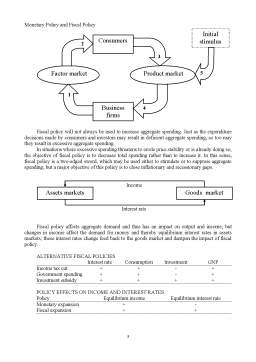Extras din proiect
Economic policy makers have access to a variety of policy instruments. The challenge is to choose the right tools at the right time. The mix of tools required may vary from problem to problem.
Type of policy
Policy instruments
Fiscal -changes in government spending
-tax cuts and increases
Monetary -open market operations
-reserve requirements
-discount rates
Supply side -tax incentives
-deregulation
-skill training and other labour-market aid
-wage-price controls
-free trade
The choice between monetary and fiscal policy as tools stabilisation policy is an important and controversial topic. One basis for decision is the flexibility with which these policies can be implemented and take effect. Here we do not discuss speed and flexibility, but rather look at what these policies do to the aggregate demand. In that respect, there is a sharp difference between monetary and fiscal policy. Monetary policy operates by stimulating interest, responsive components of aggregate demand, primarily investment spending. There is strong evidence that the earliest and strongest effect of monetary policy is on residential construction.
Fiscal policy, by contrast, operates in a manner that depends on precisely what gods the government buys or what taxes and transfers it changes. Here we might be talking of government purchases of goods and services such as defense spending or a reduction in the corporate profits tax, sales taxes, or social security contributions. Each policy affects the level of aggregate demand and causes an expansion in output, but the composition of the output increase depends on the specific policy. An investment subsidy increases investment spending. An income tax cut has a direct effect on consumption spending. All expansionary fiscal policies will raise the interest rates if the quantity of money is unchanged.
When we speak of fiscal policy, we are referring to these public tax and expenditure activities; more particularly, fiscal policy is the use of the government’s taxation and spending powers to alter macroeconomic outcomes.
An increase in government spending has a multiplied impact on total spending. The government expenditures in product markets create additional income. This added income finances increased consumption. These income and spending cycles continue until total income (spending) has increased.
Stimulus to the circular flow of income is made of:
1. increased employment
2. additional income
3. increased consumption
4. increased sales receipts
5. increased govern spending
which are represented in the next figure.
Fiscal policy will not always be used to increase aggregate spending. Just as the expenditure decisions made by consumers and investors may result in deficient aggregate spending, so too may they result in excessive aggregate spending.
In situations where excessive spending threatens to erode price stability or is already doing so, the objective of fiscal policy is to decrease total spending rather than to increase it. In this sense, fiscal policy is a two-edged sword, which may be used either to stimulate or to suppress aggregate spending; but a major objective of this policy is to close inflationary and recessionary gaps.
Income
Interest rate
Fiscal policy affects aggregate demand and thus has an impact on output and income; but changes in income affect the demand for money and thereby equilibrium interest rates in assets markets; these interest rates change feed back to the goods market and dampen the impact of fiscal policy.
Preview document
Conținut arhivă zip
- Monetary.doc
















